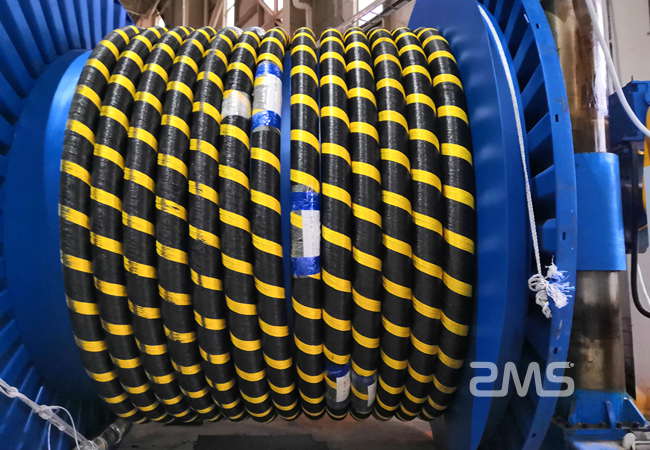Nexans To Build The World’s Longest XLPE-Insulated Submarine Cable
Nexans has been awarded the contract for the Celtic submarine grid interconnection project, jointly developed by Ireland’s EirGrid and French transmission system operator RTE. The 700 MW project is the world’s longest XLPE submarine interconnection system and the first direct submarine connection between France and Ireland.
Recognized as a Common Interest Project (PCI) by the European Union, the project allows the exchange of electricity between Ireland and France, providing power to approximately 450,000 homes and is key to the development of an integrated European energy system.
Such a system will accelerate Europe’s energy transition by facilitating the development of renewable energy sources. The project will further help the EU achieve its energy policy and climate goals of providing affordable, secure, and sustainable energy for all.
The interconnection between France and Ireland will use high-voltage DC 320 kV technology and will consist of 500 km of submarine cable lines, 40 km of underground lines in France (Brittany), and 35 km of underground lines in Ireland (County Cork).
The cables will be manufactured in Nexans’ state-of-the-art facilities. 1000 km of submarine cables will be manufactured in Halden (Norway) and 180 km of underground cables will be manufactured in Charleroi (Belgium). The fittings will be manufactured in Cortaillod (Switzerland).
According to the plan, the project will be ready for production in 2026.

Technical Properties of XLPE Cables
Cross-linked polyethylene (XLPE) insulated cables have been used on a large scale in the construction and renovation of urban distribution networks in China since the 1980s due to their excellent heat resistance and insulation properties, as well as their lightweight, high transmission capacity and ease of laying and maintenance. By the beginning of 2020, the State Grid Corporation had 2.779 million sections of distribution cables in operation, with a total length of 767,000km, an increase of 13.5% year-on-year.
At the same time, some of the early cables have entered the “aging” stage and are approaching or have exceeded their design life. How to accurately diagnose their insulation status and realize scientific operation and maintenance accordingly is particularly important to ensure the reliability of distribution network operation, and relevant research is urgently needed.
The CIGRE report also points out that aging defects are the most important cause of failure in medium voltage cables, and the problem cannot be ignored.
From 2009 to 2011, the State Grid Corporation conducted statistics on the 6~500kV power cable line faults that have been put into operation by cause, with 2,055 equipment aging faults, accounting for 21.1% of the faults, of which the main insulation aging faults accounted for 60.9% of the total equipment aging faults. In addition, compared with high-voltage cables, the fault rate of medium and low-voltage cables is higher.
For the actual operation of XLPE distribution cables, with their large spatial laying span and complex operating environment, the defects formed in the cables after the long-term operation are not uniformly distributed along the cables, and it is a major problem to effectively diagnose and locate them. Scholars at home and abroad have carried out a lot of research work on this, and although certain results have been achieved, there are still some problems and weak links that need to be solved. In addition, for economic reasons, XLPE distribution cables are generally not equipped with real-time condition monitoring devices, and the lack of historical operation data further increases the difficulty of diagnosing the aging condition of XLPE distribution cables.
The Development Of Typical Defect Diagnosis Methods And Positioning Technologies For XLPE Cables And Their Advantages
1. Improve The Sensitivity Of Diagnosing Concentrated Defects In Cables
The existing dielectric response analysis method tends to characterize the overall average aging condition of cables, and local defects may not be detected in time due to the low sensitivity of the diagnosis method, which threatens the safety of the power grid, thus there is an urgent need to improve the diagnostic sensitivity of the detection method for concentrated defects.
Frequency domain dielectric spectroscopy is more advantageous than 0.1 Hz ultra-low frequency dielectric detection and polarization/depolarization current methods for diagnosing defects in cables. Therefore, it is mainly recommended to improve the diagnostic sensitivity of concentrated defects in the following two aspects.
(1) lower the lower frequency limit of frequency domain dielectric spectrum detection to further broaden the frequency detection range. Some studies have pointed out that the lower frequency is conducive to more significant changes in tanδ during cable aging; at the same time, broadening the frequency detection range can more fully analyze the process and law of tanδ changes with frequency, which is conducive to providing more information for the identification and diagnosis of concentrated defects.
(2) Under the premise of ensuring that no damage will be caused to the cable, the test voltage of the dielectric spectrum will be further increased and high-voltage dielectric spectrum research will be carried out. For the cable in which water tree aging occurs, increasing the test voltage is conducive to promoting the increase of loss current and tanδ, and more conducive to reflecting the characteristics of nonlinear change of tanδ with test voltage.
Based on the above two aspects of research, further, explore the more effective characteristic quantity and characteristic value for the diagnosis of concentrated defects, and improve the sensitivity of the diagnosis of concentrated defects in cables.

2. Accurate Localization Of Defects In Long Cables
BIS, RCS, and other frequency-domain reflection techniques show great advantages and potential for cable defect location, but the attenuation of high-frequency measurement signals in the transmission process of longer lines cannot be ignored, which can easily lead to an increase in positioning errors or the inability to locate defects.
Given the above situation, it is recommended to conduct research from the perspective of increasing the measurement signal power, such as the use of power amplifiers to amplify the original measurement signal power, or the development of high-power impedance analysis equipment, etc., based on the original measurement signal power enhancement to alleviate and cope with the inherent attenuation process of high-frequency signals in XLPE distribution cables, which is conducive to improving the upper limit of the test frequency of the frequency-domain reflection method for long cable defect detection. This helps to increase the upper test frequency limit of the frequency-domain reflection method for long cable defect detection, thus achieving the accurate positioning of defects in long cables.
For the problem of “false peaks” in the defect location process, it is recommended to start from the correlation between “false peaks” and the “distortion peaks” formed by real defects in terms of equivalent frequency and amplitude, based on The identification and elimination of “false peaks” is achieved based on feature analysis and extraction. In addition, in the process of defect location, the formation of “false peaks” can be suppressed by adjusting the matching effect between the measuring instrument and the characteristic impedance of the first end of the cable (i.e., matching the source impedance with the transmission line impedance).
3. To Research The Location And Diagnosis Of The Local Aging Section Of The Cable
The existing frequency-domain reflection technology research has not yet achieved the identification and location of localized aging segments and concentrated defects in cables, and the existence of localized aging segments may affect the measurement signal propagation process, which in turn affects the positioning accuracy, in addition, there is still much room for expansion of the diagnosis of localized aging segment status research.
The following studies are recommended.
(1) Compare and analyze the differences between the local aging section and the impedance discontinuity formed by the concentrated defects (such as reflection coefficient change characteristics), and extract the “distortion peak” characteristics of the spatial domain function based on the frequency domain reflection method to realize the identification and positioning of the aging section and the concentrated defects.
(2) Study the influence of local aging on the measurement signal propagation speed, improve the calculation method and process of localization considering the change of wave speed, and improve the accuracy of defect localization.
(3) Considering the decay characteristics along the line and the coupling effect during the formation of different “distortion peaks”, we try to establish the correlation between the amplitude of the “distortion peaks” and the local aging state of the section, and realize the effective characterization of the aging distribution along the cable line.
